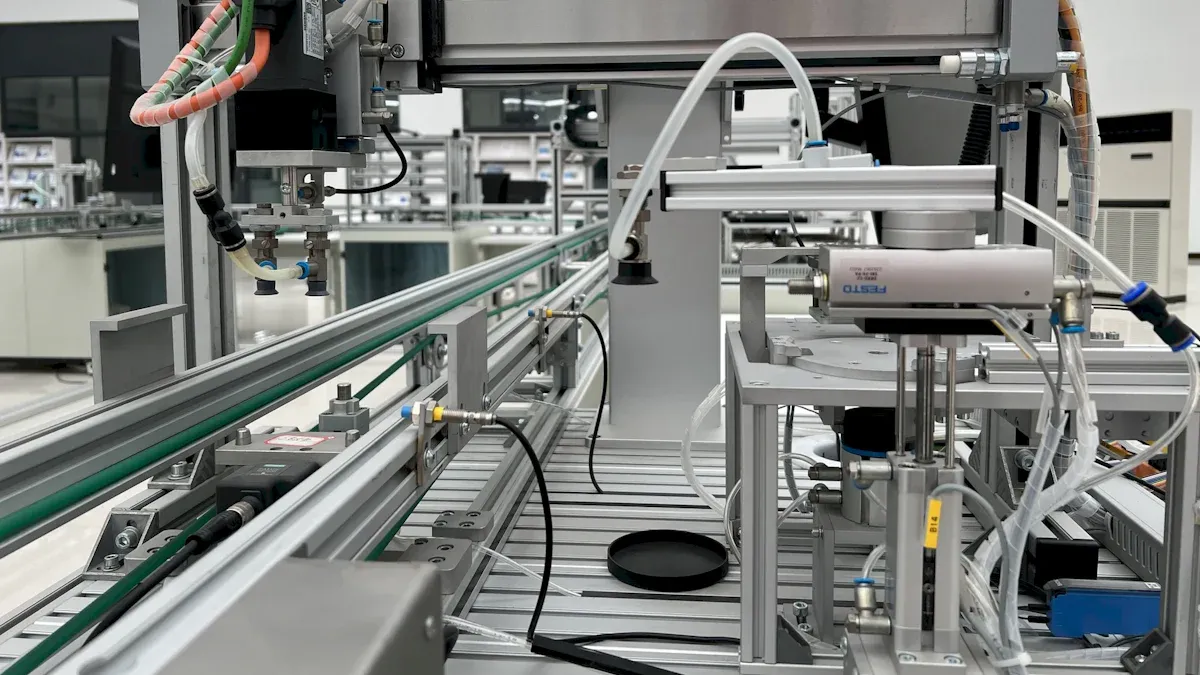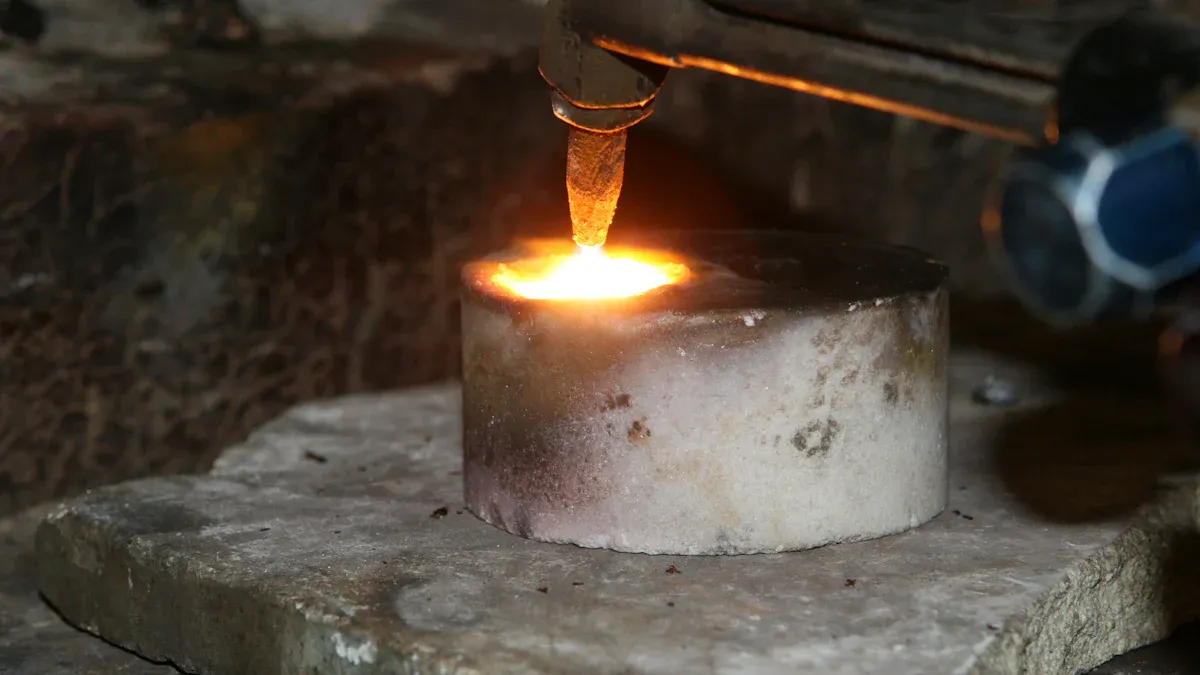
The precision casting factory industry plays a vital role in modern manufacturing, allowing the creation of intricate designs with exceptional accuracy. As a leading investment casting manufacturer, this sector has seen significant growth, with the global market valued at $16.9 billion in 2023 and projected to grow at a 6.5% CAGR, reaching $33.9 billion by 2034. This expansion underscores the importance of investment casting plants and the expertise of manufacturers of investment castings for industries worldwide.
Key Benefits of Precision Investment Casting

Design Flexibility for Complex Geometries
Precision investment casting offers unmatched design flexibility, making it ideal for creating intricate and complex geometries. Industries like aerospace, automotive, and medical rely on this process to produce high-precision components. For example:
- Aerospace: Turbine blades and structural parts with intricate designs that withstand extreme conditions.
- Automotive: Engine parts and suspension components that enhance performance and durability.
- Medical: Surgical instruments and implants with biocompatible materials and detailed designs.
Unlike traditional methods, investment casting excels in producing fine details and thin wall sections. Features like undercuts and internal designs are achievable using ceramic cores. A quick comparison highlights its advantages:
| Feature | Investment Casting | Traditional Methods |
|---|---|---|
| Precision | High | Moderate |
| Complexity of Design | Complex | Limited |
| Surface Finish | Superior | Rough |
| Need for Machining | Minimal | Extensive |
This flexibility allows manufacturers of investment castings to meet the unique demands of various industries.
Material Efficiency and Waste Reduction
Precision investment casting minimizes waste by producing components closer to their final shape. This reduces the need for extensive machining, saving both material and costs. Companies adopting this process can cut operational costs by up to 30%. Additionally, the ability to achieve tighter tolerances and smoother finishes further reduces material waste.
Greater material efficiency also enhances production timelines. By reducing post-casting work, manufacturers of investment castings can deliver high-quality products faster, meeting tight deadlines without compromising quality.
Cost-Effectiveness in Production
Investment casting is a cost-effective solution for manufacturers. It reduces lead times by minimizing machining requirements and allows for the creation of single-piece castings, eliminating the need for multi-piece assemblies. This not only lowers production costs but also simplifies the manufacturing process.
For industries requiring high-quality components, the process ensures affordability without sacrificing precision. Manufacturers of investment castings benefit from reduced tooling costs and streamlined production, making it a preferred choice for both small and large-scale operations.
Applications of Precision Investment Casting

Aerospace and Defense
Precision investment casting plays a vital role in aerospace and defense. It enables the production of highly accurate components with complex geometries, meeting the stringent demands of these industries. Manufacturers use this process to create parts like housings, mounts, brackets, and engine components. These parts often require tolerances as tight as ±0.005 per inch, ensuring reliability in mission-critical applications.
The process also reduces the risk of defects by consolidating components into single-piece designs. This eliminates weak points caused by welding and enhances overall strength. Additionally, investment casting minimizes machining needs, saving time and resources. With its ability to handle a wide range of alloys, it supports the creation of lightweight, high-strength parts essential for advanced military and aerospace technologies.
Automotive and Transportation
In the automotive sector, precision investment casting is ideal for producing intricate parts with tight tolerances and smooth finishes. Components like engine parts and fuel injection systems benefit from this process. These castings are not only robust but also lightweight, improving vehicle performance and fuel efficiency.
The method allows for the combination of multiple wax patterns, enabling unique mold designs that traditional machining cannot achieve. This versatility helps manufacturers meet the high volume and strict quality standards of the automotive industry. By reducing the need for extensive machining, investment casting also lowers production costs while maintaining precision.
Medical and Healthcare Equipment
The medical field relies on precision investment casting for its ability to produce high-quality surgical tools and implantable devices. These components require exceptional accuracy and biocompatibility to ensure safety and effectiveness. Instruments like bone saws and scalpels benefit from the process’s ability to create complex shapes with tight tolerances.
Durability and corrosion resistance are critical for medical equipment, especially in high-traffic areas. Investment casting ensures these properties by using project-specific alloys. Advanced quality control methods, including non-destructive testing, further guarantee the reliability of each component, making it a trusted choice for healthcare applications.
Industrial and Energy Sectors
Precision investment casting supports the industrial and energy sectors by delivering components with remarkable strength and thermal stability. Applications include turbine blades, valve brackets, and structural parts for power plants. The process uses heat-resistant alloys to withstand extreme environments, ensuring long-lasting performance.
By reducing material waste and post-casting machining, investment casting enhances efficiency and lowers costs. Its flexibility in design also allows for the customization of parts to meet specific energy production requirements. This makes it an economical and reliable solution for industries like oil and gas, wind energy, and nuclear power.
Technical and Economic Advantages
Achieving Tight Tolerances and Superior Surface Finish
Precision investment casting stands out for its ability to achieve tight tolerances and exceptional surface finishes. This process allows manufacturers to redesign parts with complex shapes, saving time and reducing costs. For industries where precision is critical, such as aerospace and medical, this accuracy ensures reliable performance.
- Dimensional accuracy is a hallmark of investment casting, with tolerances as tight as ±0.005 per inch.
- Compared to die casting, which typically exceeds .003″, investment casting offers superior precision.
| Casting Process | Tolerance |
|---|---|
| Investment Casting | .003″ |
| Die Casting | > .003″ |
The process also minimizes machining and polishing needs. Components come out with smooth finishes and intricate details, cutting down on production time. This makes investment casting a go-to choice for industries requiring both functionality and aesthetics.
Scalability for Small and Large Production Runs
Scalability is another key advantage of precision investment casting. Whether producing a few prototypes or thousands of units, the process adapts seamlessly to different production scales. This flexibility benefits manufacturers across various industries.
- It ensures consistent quality, vital for maintaining industry standards.
- Design flexibility accommodates diverse needs, from automotive parts to medical tools.
- Reduced material waste enhances cost-effectiveness and sustainability.
- Low tooling costs make it economical for small runs.
- Consistent quality ensures reliability for large-scale production.
- The ability to eliminate material waste supports eco-friendly practices.
This adaptability makes investment casting a practical solution for manufacturers of investment castings, regardless of production volume.
Cost Savings Through Affordable Tooling
Affordable tooling significantly reduces production costs in precision investment casting. The tooling used in this process lasts longer than those in other methods, lowering overall expenses. Near-net-shape parts require minimal machining, further cutting costs.
| Benefit | Description |
|---|---|
| Longer Tool Life | Investment casting tooling lasts longer than other processes. |
| Lower Costs | Near-net-shape parts require less machining, reducing expenses. |
| Reduced Lead Times | High-quality products need less post-casting work, speeding up production. |
Additionally, aluminum dies allow for easy alterations, keeping tooling costs low. This affordability makes investment casting an attractive option for manufacturers aiming to optimize their budgets.
Supporting Sustainable Manufacturing Practices
Precision investment casting supports sustainable manufacturing by reducing waste and energy consumption. Manufacturers can recycle wax patterns and ceramic shell materials, minimizing environmental impact. Advanced technologies like induction furnaces improve metal melting efficiency, saving energy.
- Automating wax pattern assembly reduces scrap and machining needs.
- Closed-loop systems in chillers and waste heat recovery systems enhance energy efficiency.
- Renewable energy sources, such as solar or wind, further lower the carbon footprint.
By adopting these practices, manufacturers contribute to a greener future while maintaining high production standards. This aligns with the growing demand for sustainable solutions in modern manufacturing.
Precision investment casting has become a cornerstone of modern manufacturing. Its ability to produce high-quality components with tight tolerances and smooth finishes reduces lead times and costs. Industries like aerospace and automotive rely on this process for its precision and versatility.
As industries evolve, advancements like 3D printing and sustainable practices will drive innovation. Companies adopting eco-friendly methods can reduce energy costs by up to 15%, aligning with global trends. This positions precision investment casting as a key driver of efficiency and sustainability in the future of manufacturing.
FAQ
What is precision investment casting?
Precision investment casting is a manufacturing process that creates detailed components by pouring molten metal into a ceramic mold. It ensures high accuracy and smooth finishes. 🛠️
Why is it better than traditional casting methods?
It offers superior precision, reduced waste, and design flexibility. Manufacturers can produce complex shapes with minimal machining, saving time and costs. 🚀
Can investment casting handle large production volumes?
Yes! Investment casting scales well for both small and large production runs. It ensures consistent quality and cost-effectiveness, making it ideal for various industries. ✅
